Abstract
31P n.m.r. spectroscopy was used to measure the concentration of phosphates commonly proposed to control oxidative phosphorylation. The effect of loading conditions, beta-adrenergic stimulation and different substrates (acetate, pyruvate or glucose) was examined under steady-state conditions in the isolated working rat heart. Oxygen consumption and haemodynamic variables were monitored continuously. In response to a 2-fold increase in afterload, there were no significant changes in [ADP], [ATP]/[ADP], or [ATP]/[ADP][Pi]. In the presence of isoprenaline, these variables also tended not to change from afterload. However, isoprenaline, at identical perfusion pressures, consistently decreased the phosphorylation potential and [ATP]/[ADP], but had little effect on [ADP]. Substrates altered the phosphate metabolites in a manner independent of oxygen consumption, and had only minor effects on the relationship between phosphates and work, in contrast with other studies. Thus, metabolites of ATP synthesis are not normally involved in respiratory control. The 31P n.m.r. spectrum can vary greatly, but does not predict oxygen consumption in this preparation. Substrates have no effect on the mechanism of respiratory control. Thus the normal control of respiration in the heart at steady state cannot occur at the level of its substrates. Rather, there must be concerted regulation of the numerous pathways, involving allostery and covalent modification. The attention of future research should be shifted away from the metabolites of ATP and towards identifying the effectors of such regulation.
Full text
PDF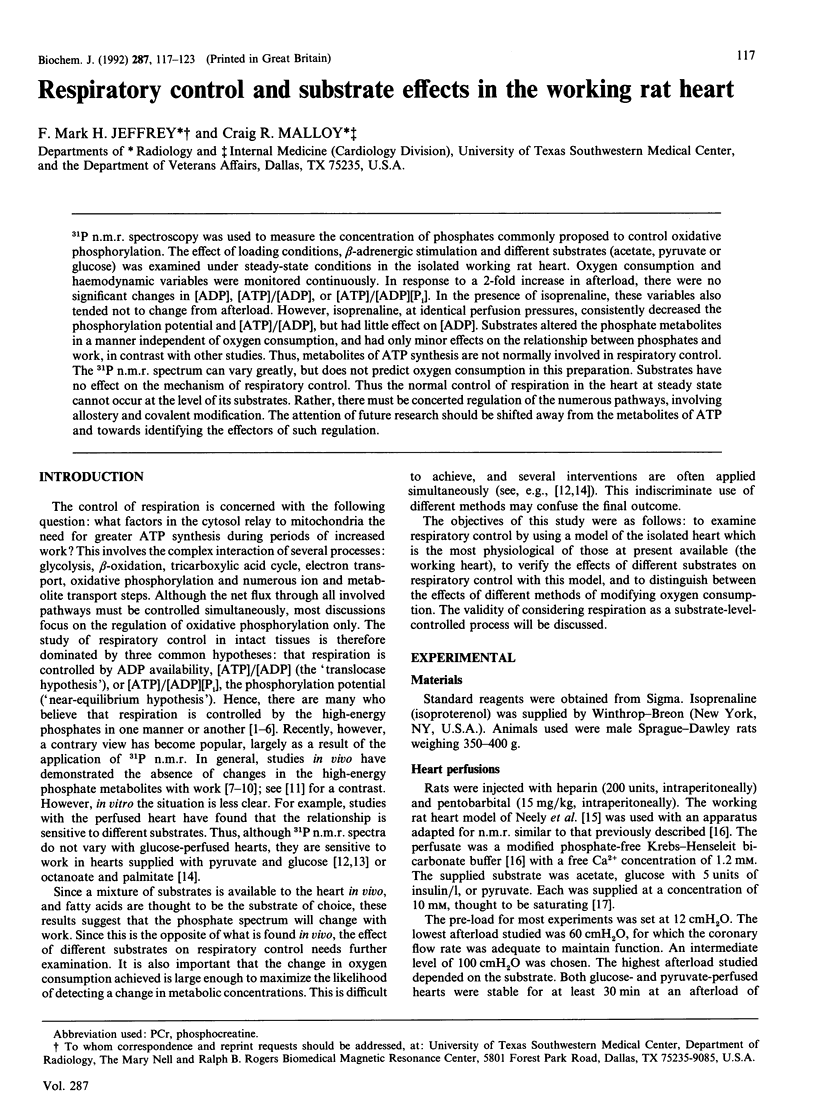
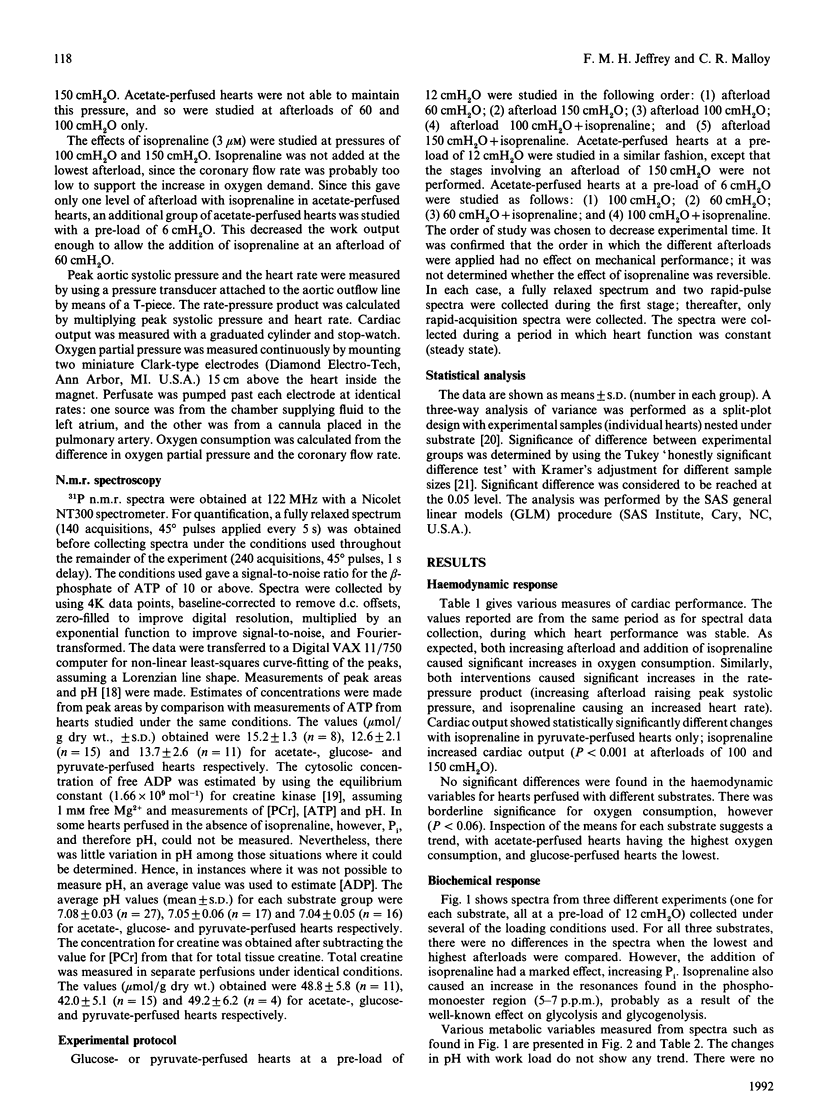
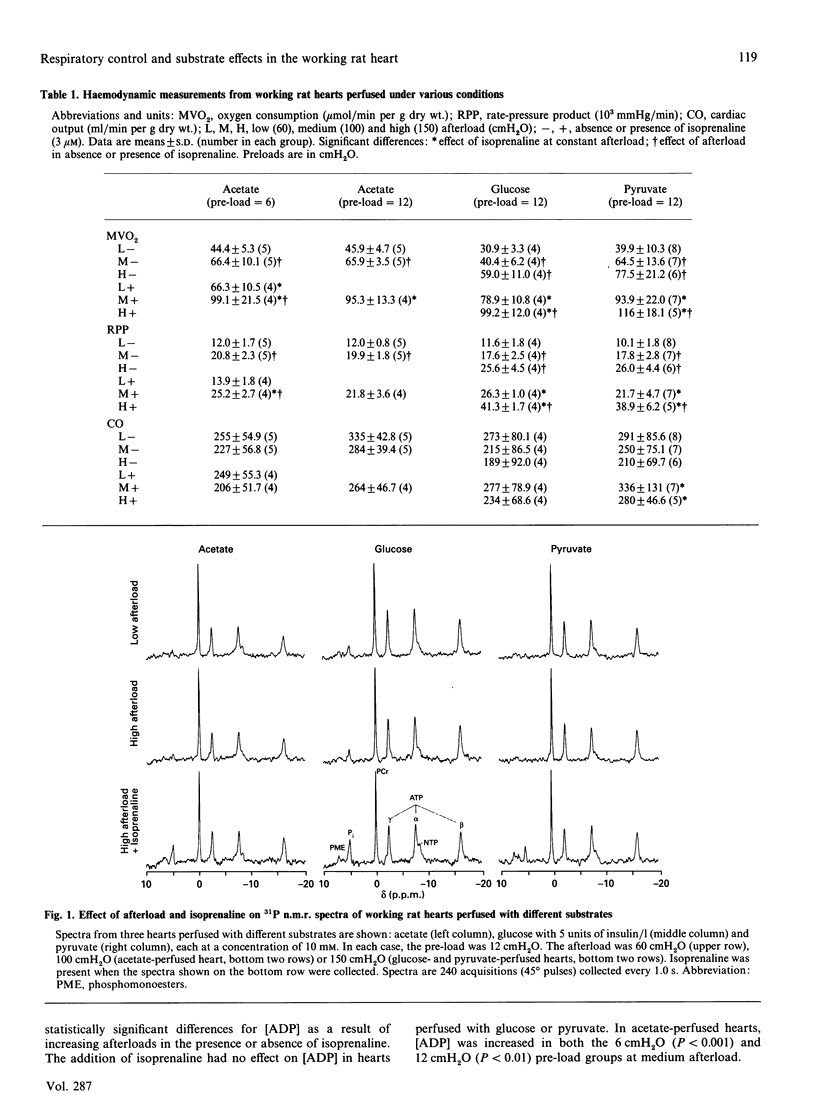
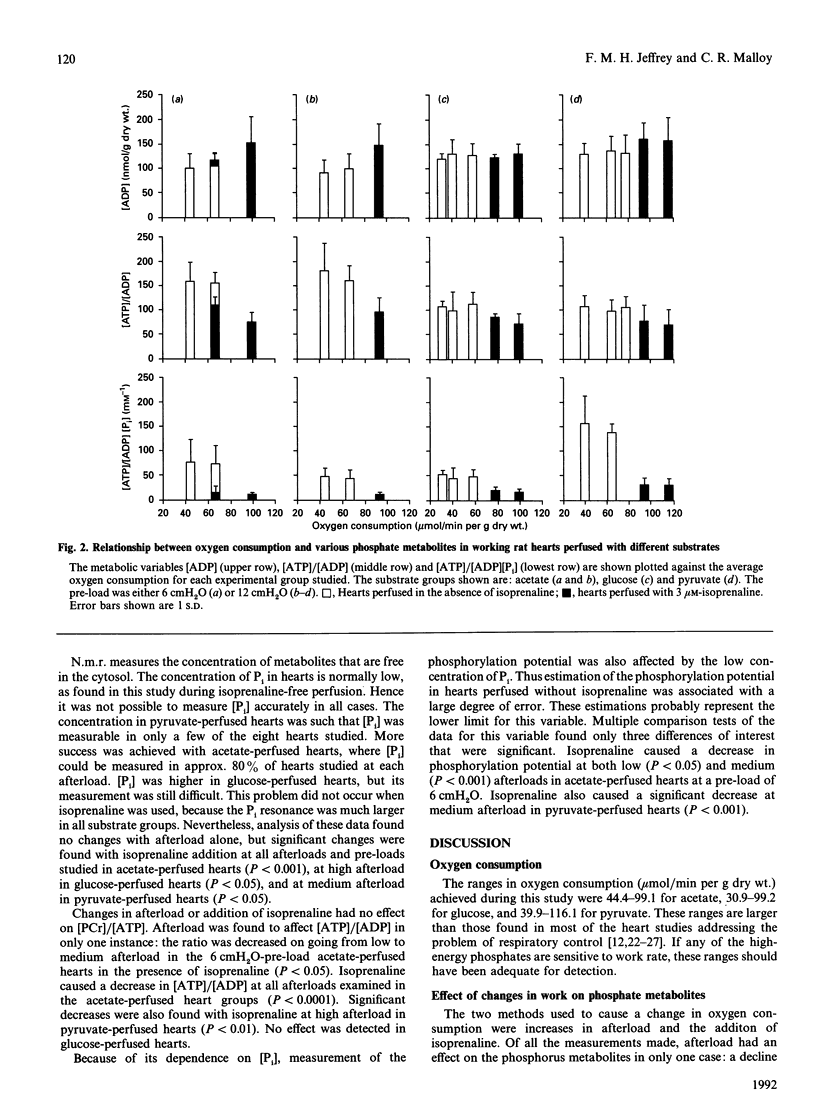
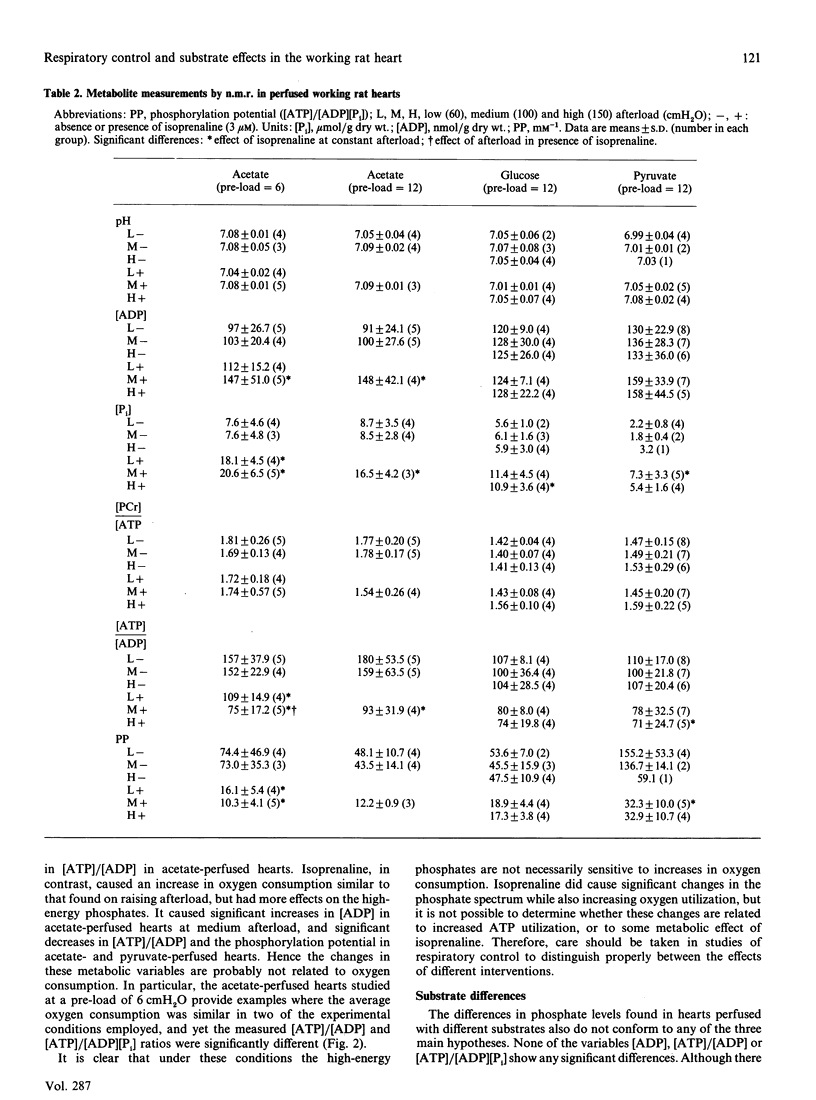
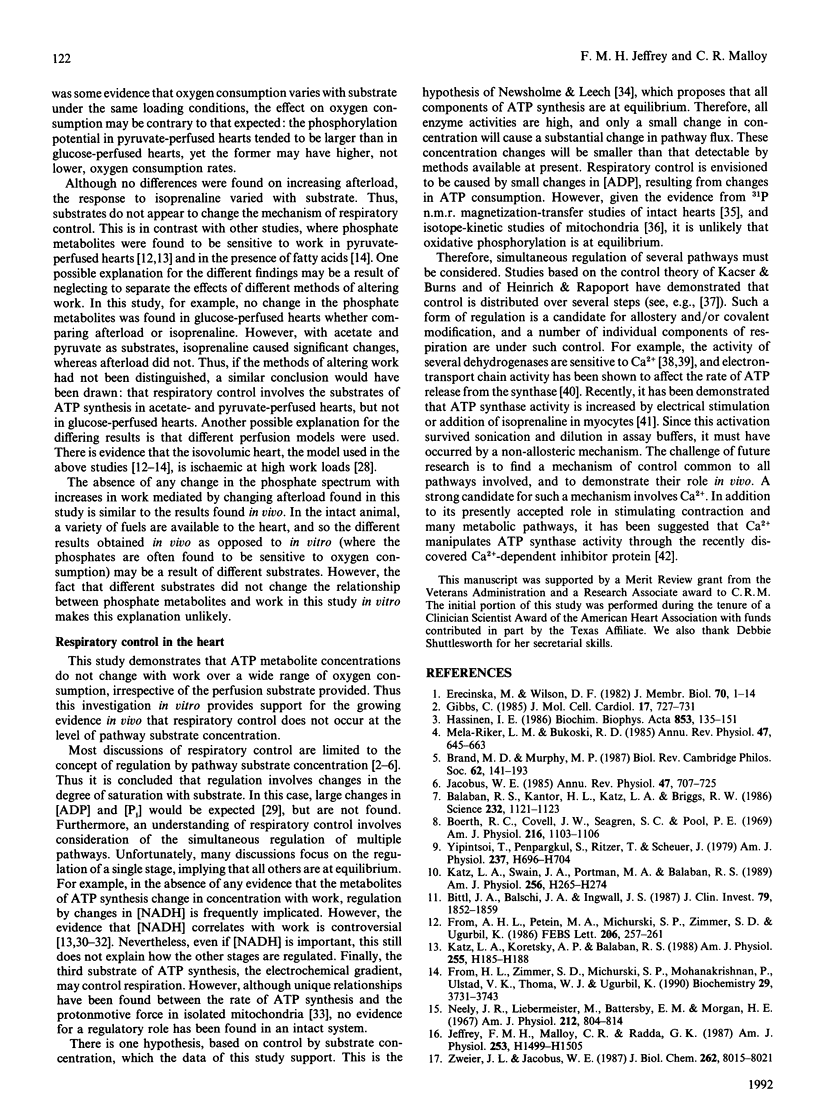
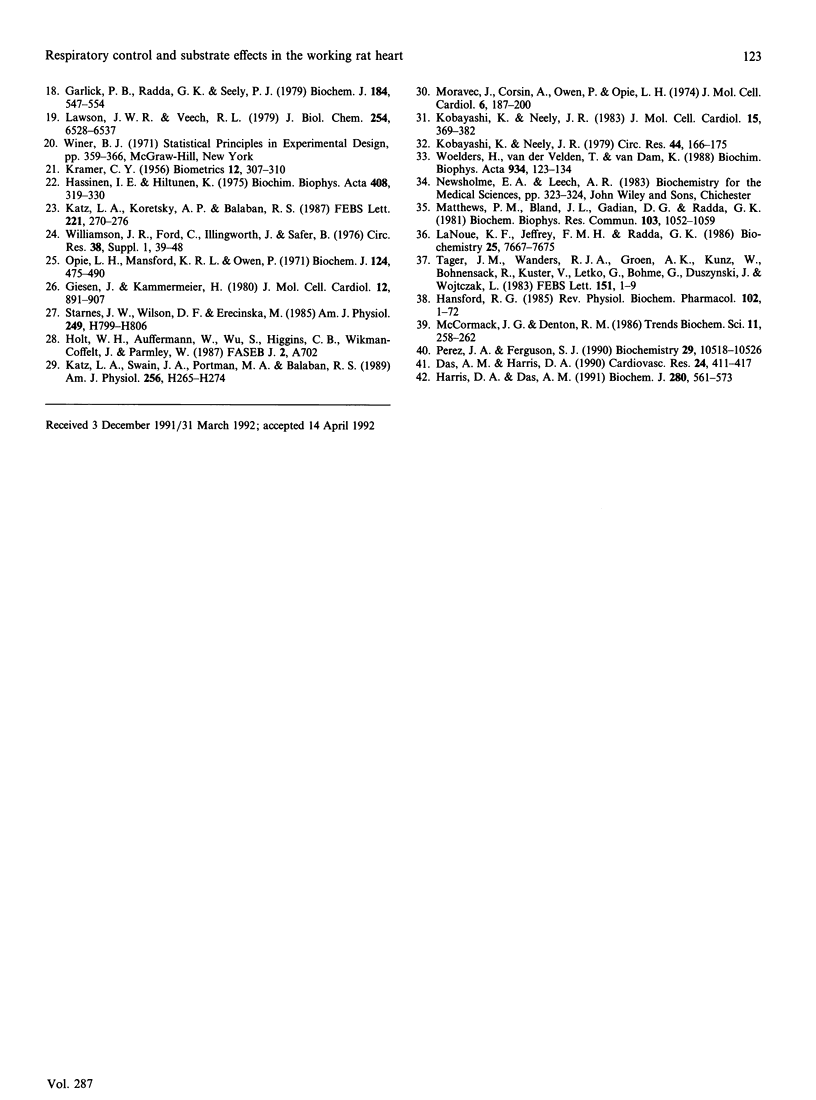
Selected References
These references are in PubMed. This may not be the complete list of references from this article.
- Balaban R. S., Kantor H. L., Katz L. A., Briggs R. W. Relation between work and phosphate metabolite in the in vivo paced mammalian heart. Science. 1986 May 30;232(4754):1121–1123. doi: 10.1126/science.3704638. [DOI] [PubMed] [Google Scholar]
- Bittl J. A., Balschi J. A., Ingwall J. S. Effects of norepinephrine infusion on myocardial high-energy phosphate content and turnover in the living rat. J Clin Invest. 1987 Jun;79(6):1852–1859. doi: 10.1172/JCI113027. [DOI] [PMC free article] [PubMed] [Google Scholar]
- Boerth R. C., Covell J. W., Seagren S. C., Pool P. E. High-energy phosphate concentrations in dog myocardium during stress. Am J Physiol. 1969 May;216(5):1103–1106. doi: 10.1152/ajplegacy.1969.216.5.1103. [DOI] [PubMed] [Google Scholar]
- Brand M. D., Murphy M. P. Control of electron flux through the respiratory chain in mitochondria and cells. Biol Rev Camb Philos Soc. 1987 May;62(2):141–193. doi: 10.1111/j.1469-185x.1987.tb01265.x. [DOI] [PubMed] [Google Scholar]
- Das A. M., Harris D. A. Control of mitochondrial ATP synthase in heart cells: inactive to active transitions caused by beating or positive inotropic agents. Cardiovasc Res. 1990 May;24(5):411–417. doi: 10.1093/cvr/24.5.411. [DOI] [PubMed] [Google Scholar]
- Erecińska M., Wilson D. F. Regulation of cellular energy metabolism. J Membr Biol. 1982;70(1):1–14. doi: 10.1007/BF01871584. [DOI] [PubMed] [Google Scholar]
- From A. H., Petein M. A., Michurski S. P., Zimmer S. D., Uğurbil K. 31P-NMR studies of respiratory regulation in the intact myocardium. FEBS Lett. 1986 Oct 6;206(2):257–261. doi: 10.1016/0014-5793(86)80992-9. [DOI] [PubMed] [Google Scholar]
- From A. H., Zimmer S. D., Michurski S. P., Mohanakrishnan P., Ulstad V. K., Thoma W. J., Uğurbil K. Regulation of the oxidative phosphorylation rate in the intact cell. Biochemistry. 1990 Apr 17;29(15):3731–3743. doi: 10.1021/bi00467a020. [DOI] [PubMed] [Google Scholar]
- Garlick P. B., Radda G. K., Seeley P. J. Studies of acidosis in the ischaemic heart by phosphorus nuclear magnetic resonance. Biochem J. 1979 Dec 15;184(3):547–554. doi: 10.1042/bj1840547. [DOI] [PMC free article] [PubMed] [Google Scholar]
- Gibbs C. The cytoplasmic phosphorylation potential. Its possible role in the control of myocardial respiration and cardiac contractility. J Mol Cell Cardiol. 1985 Aug;17(8):727–731. doi: 10.1016/s0022-2828(85)80034-1. [DOI] [PubMed] [Google Scholar]
- Giesen J., Kammermeier H. Relationship of phosphorylation potential and oxygen consumption in isolated perfused rat hearts. J Mol Cell Cardiol. 1980 Sep;12(9):891–907. doi: 10.1016/0022-2828(80)90058-9. [DOI] [PubMed] [Google Scholar]
- Hansford R. G. Relation between mitochondrial calcium transport and control of energy metabolism. Rev Physiol Biochem Pharmacol. 1985;102:1–72. doi: 10.1007/BFb0034084. [DOI] [PubMed] [Google Scholar]
- Harris D. A., Das A. M. Control of mitochondrial ATP synthesis in the heart. Biochem J. 1991 Dec 15;280(Pt 3):561–573. doi: 10.1042/bj2800561. [DOI] [PMC free article] [PubMed] [Google Scholar]
- Hassinen I. E., Hiltunen K. Respiratory control in isolated perfused rat heart. Role of the equilibrium relations between the mitochondrial electron carriers and the adenylate system. Biochim Biophys Acta. 1975 Dec 11;408(3):319–330. doi: 10.1016/0005-2728(75)90133-4. [DOI] [PubMed] [Google Scholar]
- Hassinen I. E. Mitochondrial respiratory control in the myocardium. Biochim Biophys Acta. 1986;853(2):135–151. doi: 10.1016/0304-4173(86)90008-x. [DOI] [PubMed] [Google Scholar]
- Jacobus W. E. Respiratory control and the integration of heart high-energy phosphate metabolism by mitochondrial creatine kinase. Annu Rev Physiol. 1985;47:707–725. doi: 10.1146/annurev.ph.47.030185.003423. [DOI] [PubMed] [Google Scholar]
- Jeffrey F. M., Malloy C. R., Radda G. K. Influence of intracellular acidosis on contractile function in the working rat heart. Am J Physiol. 1987 Dec;253(6 Pt 2):H1499–H1505. doi: 10.1152/ajpheart.1987.253.6.H1499. [DOI] [PubMed] [Google Scholar]
- Katz L. A., Koretsky A. P., Balaban R. S. Activation of dehydrogenase activity and cardiac respiration: a 31P-NMR study. Am J Physiol. 1988 Jul;255(1 Pt 2):H185–H188. doi: 10.1152/ajpheart.1988.255.1.H185. [DOI] [PubMed] [Google Scholar]
- Katz L. A., Koretsky A. P., Balaban R. S. Respiratory control in the glucose perfused heart. A 31P NMR and NADH fluorescence study. FEBS Lett. 1987 Sep 14;221(2):270–276. doi: 10.1016/0014-5793(87)80939-0. [DOI] [PubMed] [Google Scholar]
- Katz L. A., Swain J. A., Portman M. A., Balaban R. S. Relation between phosphate metabolites and oxygen consumption of heart in vivo. Am J Physiol. 1989 Jan;256(1 Pt 2):H265–H274. doi: 10.1152/ajpheart.1989.256.1.H265. [DOI] [PubMed] [Google Scholar]
- Katz L. A., Swain J. A., Portman M. A., Balaban R. S. Relation between phosphate metabolites and oxygen consumption of heart in vivo. Am J Physiol. 1989 Jan;256(1 Pt 2):H265–H274. doi: 10.1152/ajpheart.1989.256.1.H265. [DOI] [PubMed] [Google Scholar]
- Kobayashi K., Neely J. R. Control of maximum rates of glycolysis in rat cardiac muscle. Circ Res. 1979 Feb;44(2):166–175. doi: 10.1161/01.res.44.2.166. [DOI] [PubMed] [Google Scholar]
- Kobayashi K., Neely J. R. Mechanism of pyruvate dehydrogenase activation by increased cardiac work. J Mol Cell Cardiol. 1983 Jun;15(6):369–382. doi: 10.1016/0022-2828(83)90321-8. [DOI] [PubMed] [Google Scholar]
- LaNoue K. F., Jeffries F. M., Radda G. K. Kinetic control of mitochondrial ATP synthesis. Biochemistry. 1986 Nov 18;25(23):7667–7675. doi: 10.1021/bi00371a058. [DOI] [PubMed] [Google Scholar]
- Lawson J. W., Veech R. L. Effects of pH and free Mg2+ on the Keq of the creatine kinase reaction and other phosphate hydrolyses and phosphate transfer reactions. J Biol Chem. 1979 Jul 25;254(14):6528–6537. [PubMed] [Google Scholar]
- Matthews P. M., Bland J. L., Gadian D. G., Radda G. K. The steady-state rate of ATP synthesis in the perfused rat heart measured by 31P NMR saturation transfer. Biochem Biophys Res Commun. 1981 Dec 15;103(3):1052–1059. doi: 10.1016/0006-291x(81)90915-3. [DOI] [PubMed] [Google Scholar]
- Mela-Riker L. M., Bukoski R. D. Regulation of mitochondrial activity in cardiac cells. Annu Rev Physiol. 1985;47:645–663. doi: 10.1146/annurev.ph.47.030185.003241. [DOI] [PubMed] [Google Scholar]
- Moravec J., Corsin A., Owen P., Opie L. H. Effect of increased aortic perfusion pressure on fluorescent emission of the isolated rat heart. J Mol Cell Cardiol. 1974 Apr;6(2):187–200. doi: 10.1016/0022-2828(74)90021-2. [DOI] [PubMed] [Google Scholar]
- Neely J. R., Liebermeister H., Battersby E. J., Morgan H. E. Effect of pressure development on oxygen consumption by isolated rat heart. Am J Physiol. 1967 Apr;212(4):804–814. doi: 10.1152/ajplegacy.1967.212.4.804. [DOI] [PubMed] [Google Scholar]
- Opie L. H., Mansford K. R., Owen P. Effects of increased heart work on glycolysis and adenine nucleotides in the perfused heart of normal and diabetic rats. Biochem J. 1971 Sep;124(3):475–490. doi: 10.1042/bj1240475. [DOI] [PMC free article] [PubMed] [Google Scholar]
- Pérez J. A., Ferguson S. J. Kinetics of oxidative phosphorylation in Paracoccus denitrificans. 2. Evidence for a kinetic and thermodynamic modulation of F0F1-ATPase by the activity of the respiratory chain. Biochemistry. 1990 Nov 20;29(46):10518–10526. doi: 10.1021/bi00498a014. [DOI] [PubMed] [Google Scholar]
- Starnes J. W., Wilson D. F., Erecińska M. Substrate dependence of metabolic state and coronary flow in perfused rat heart. Am J Physiol. 1985 Oct;249(4 Pt 2):H799–H806. doi: 10.1152/ajpheart.1985.249.4.H799. [DOI] [PubMed] [Google Scholar]
- Tager J. M., Wanders R. J., Groen A. K., Kunz W., Bohnensack R., Küster U., Letko G., Böhme G., Duszynski J., Wojtczak L. Control of mitochondrial respiration. FEBS Lett. 1983 Jan 10;151(1):1–9. doi: 10.1016/0014-5793(83)80330-5. [DOI] [PubMed] [Google Scholar]
- Woelders H., van der Velden T., van Dam K. Unique relationships between the rates of oxidation and phosphorylation and the protonmotive force in rat-liver mitochondria. Biochim Biophys Acta. 1988 Jun 15;934(1):123–134. doi: 10.1016/0005-2728(88)90127-2. [DOI] [PubMed] [Google Scholar]
- Yipintsoi T., Penpargkul S., Ritzer T., Scheuer J. Myocardial energy supply-demand factors: flow and metabolism during isoproterenol infusion in dogs. Am J Physiol. 1979 Dec;237(6):H696–H704. doi: 10.1152/ajpheart.1979.237.6.H696. [DOI] [PubMed] [Google Scholar]
- Zweier J. L., Jacobus W. E. Substrate-induced alterations of high energy phosphate metabolism and contractile function in the perfused heart. J Biol Chem. 1987 Jun 15;262(17):8015–8021. [PubMed] [Google Scholar]


